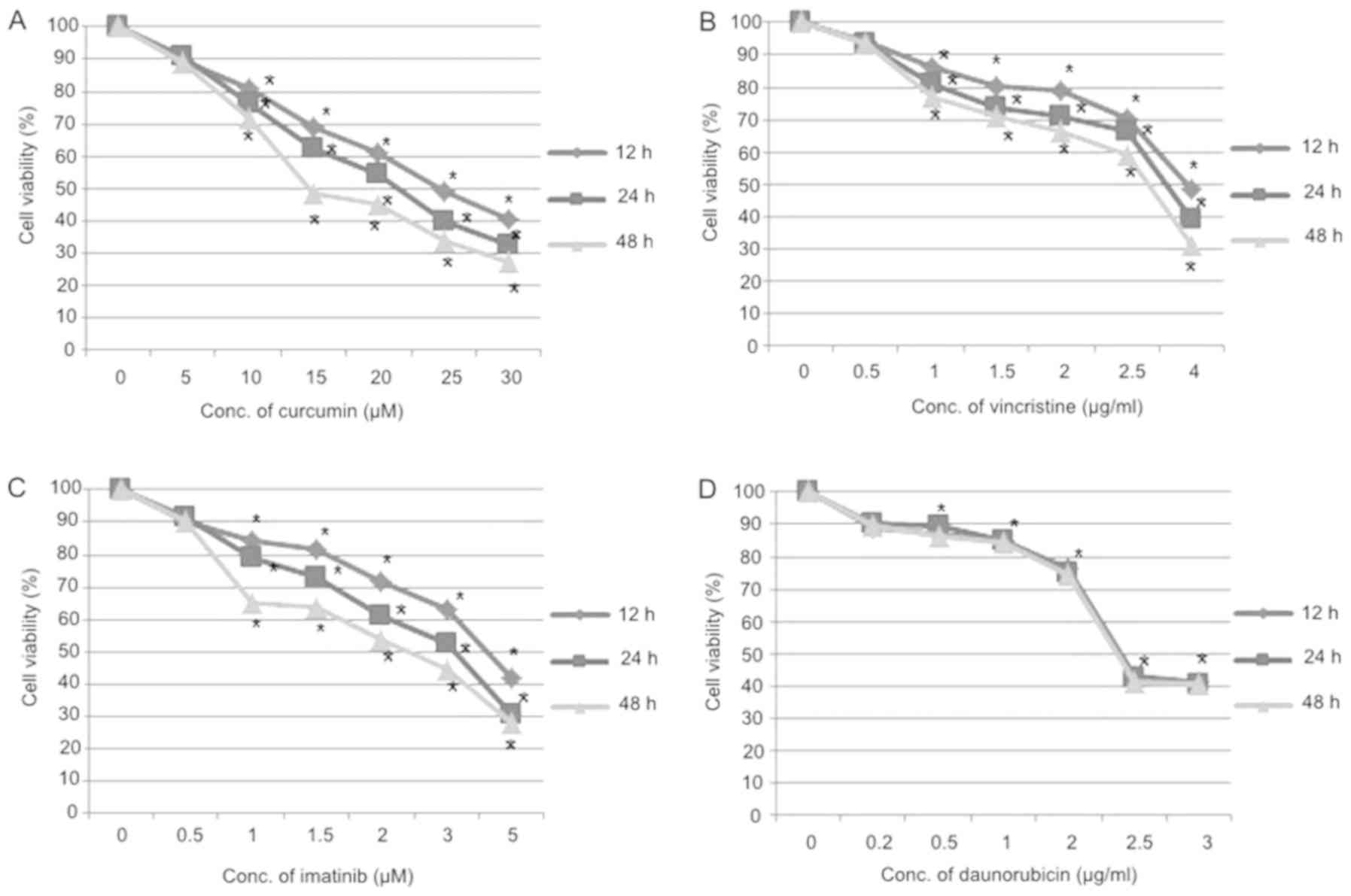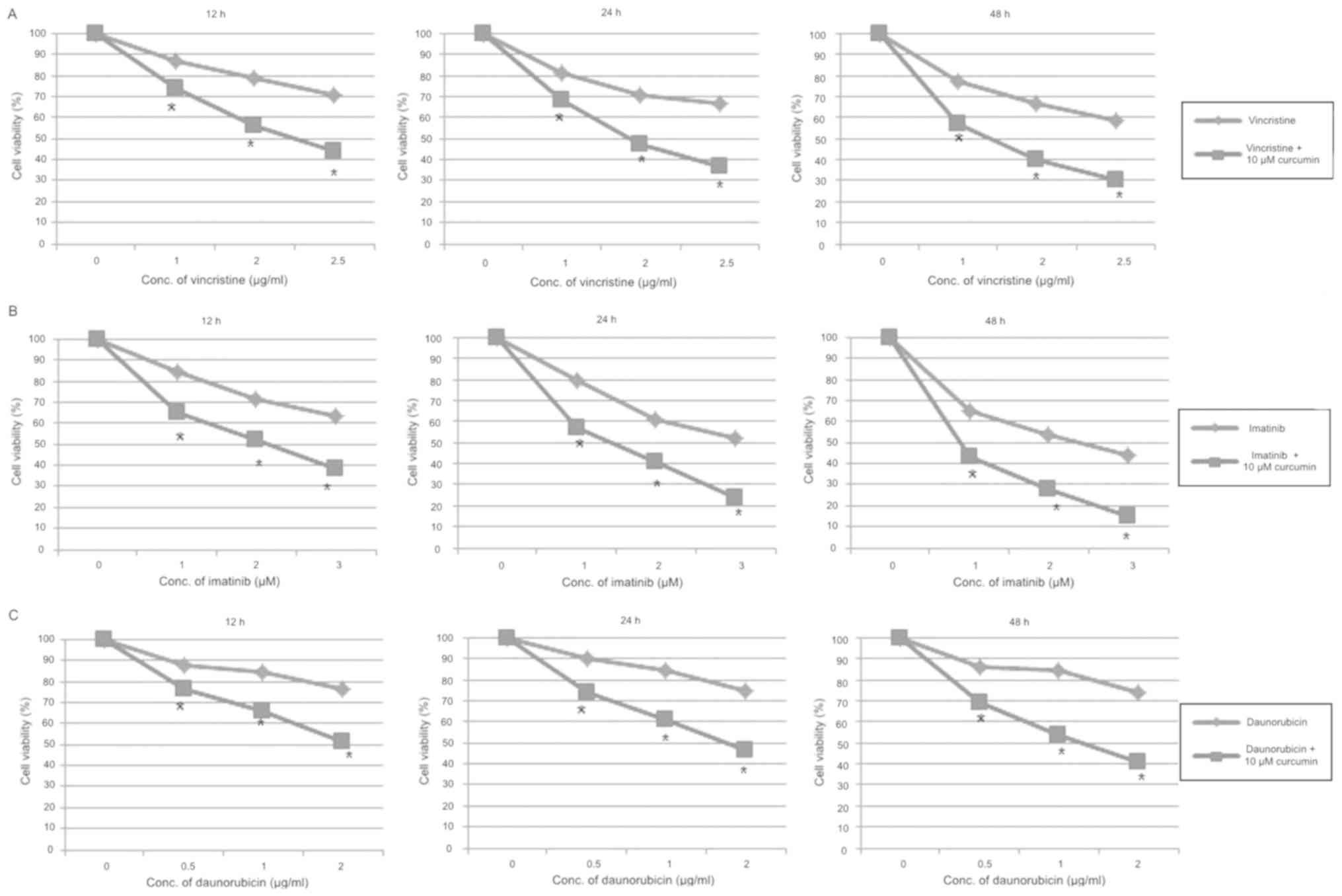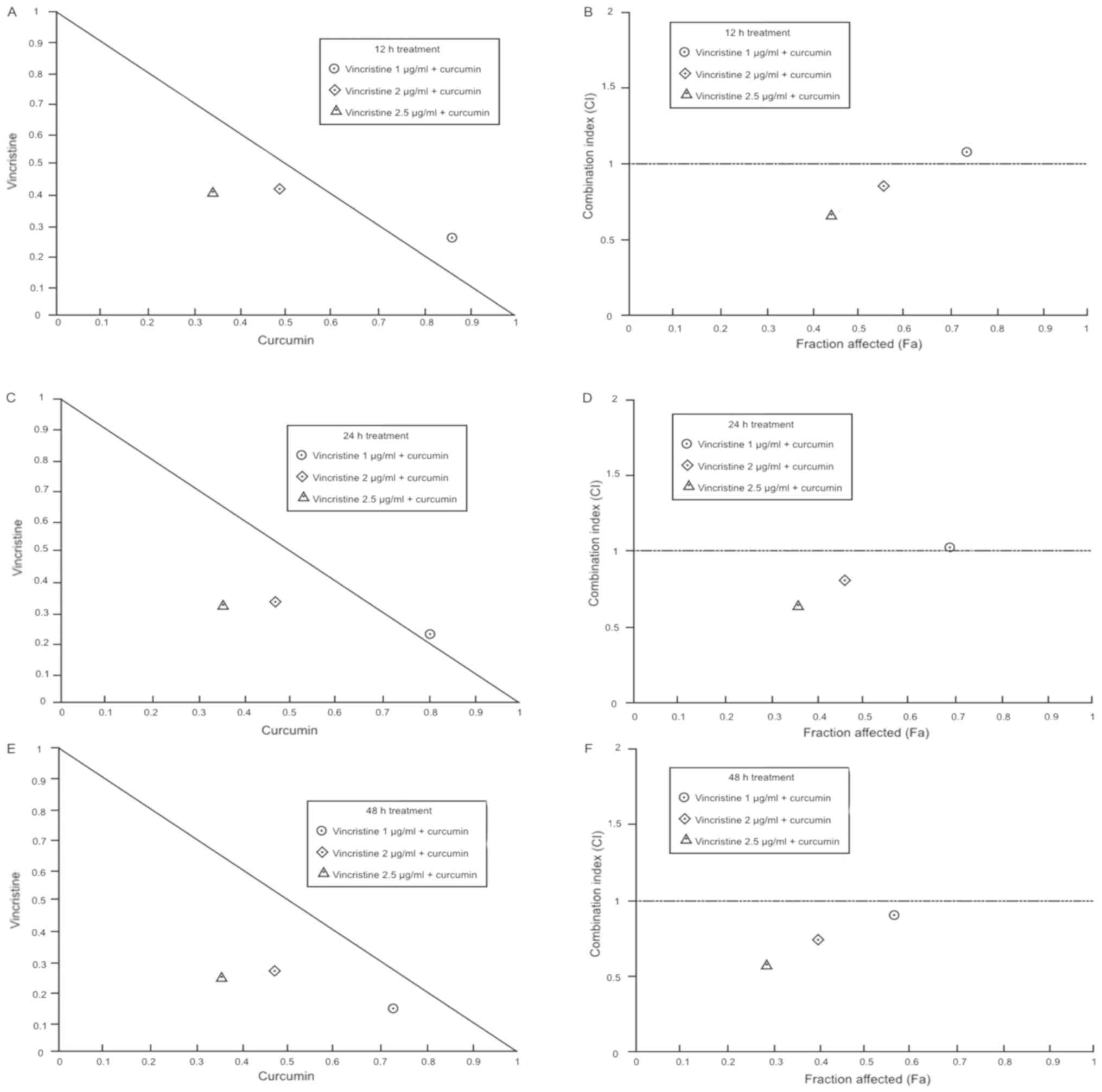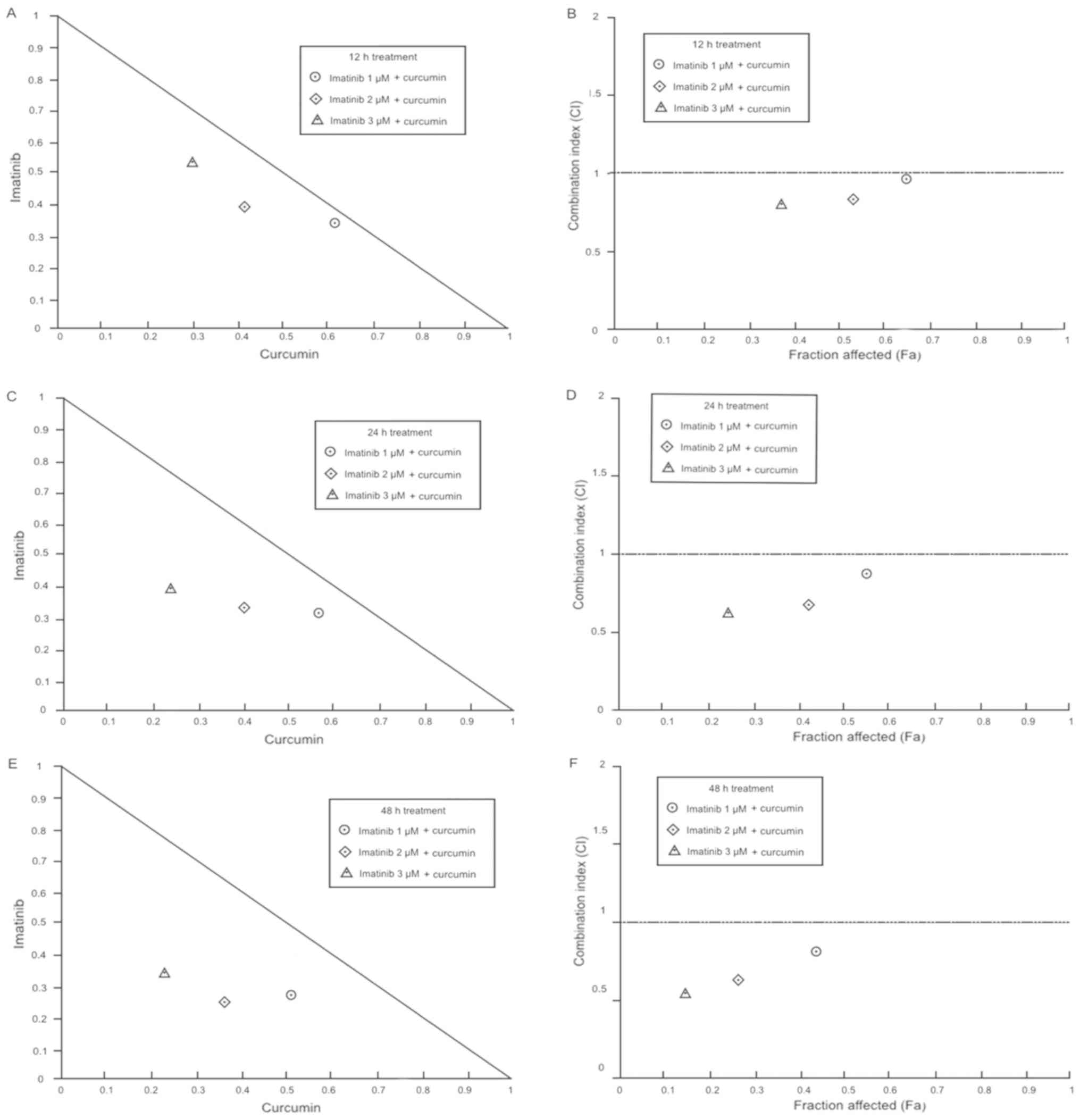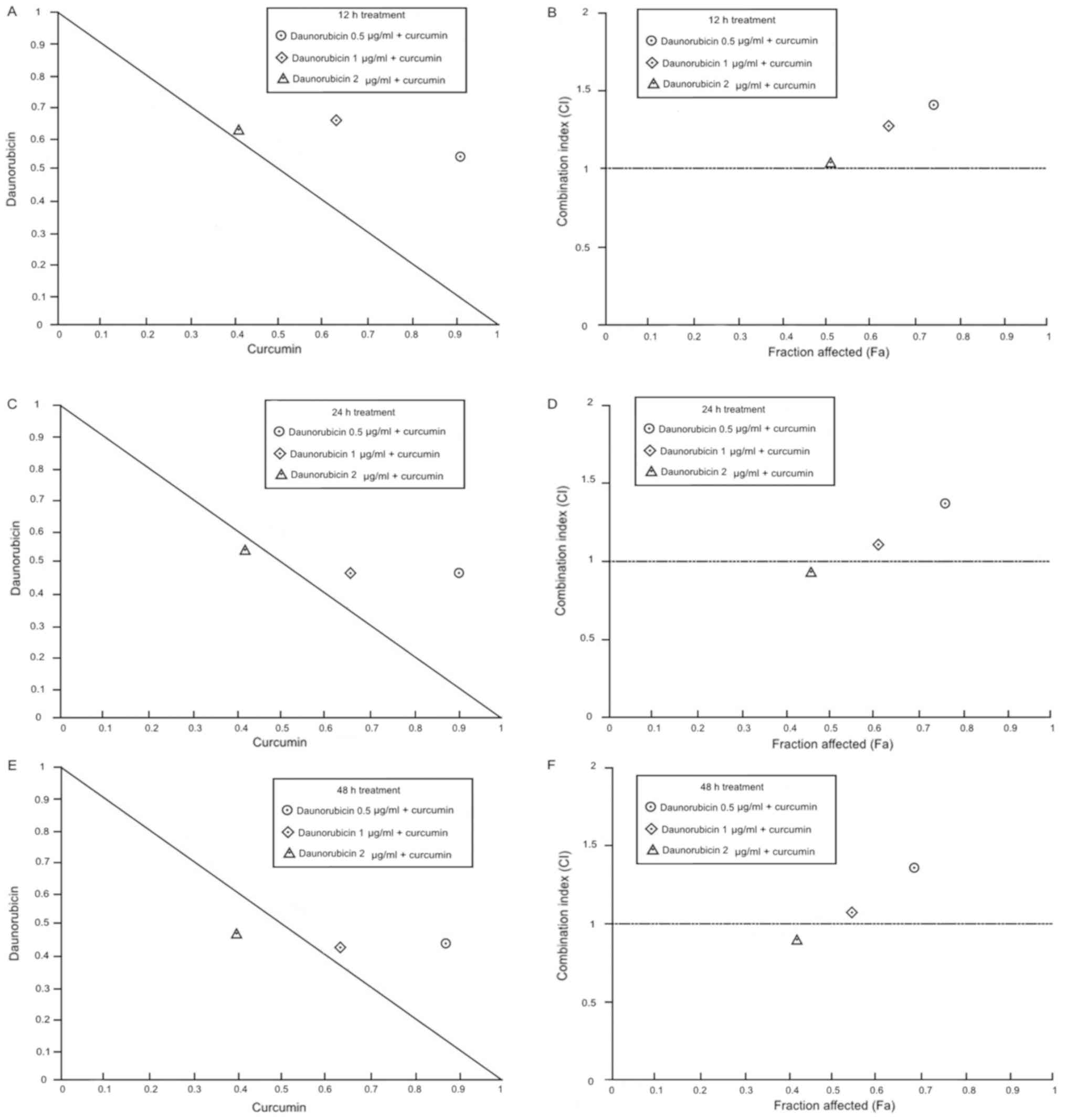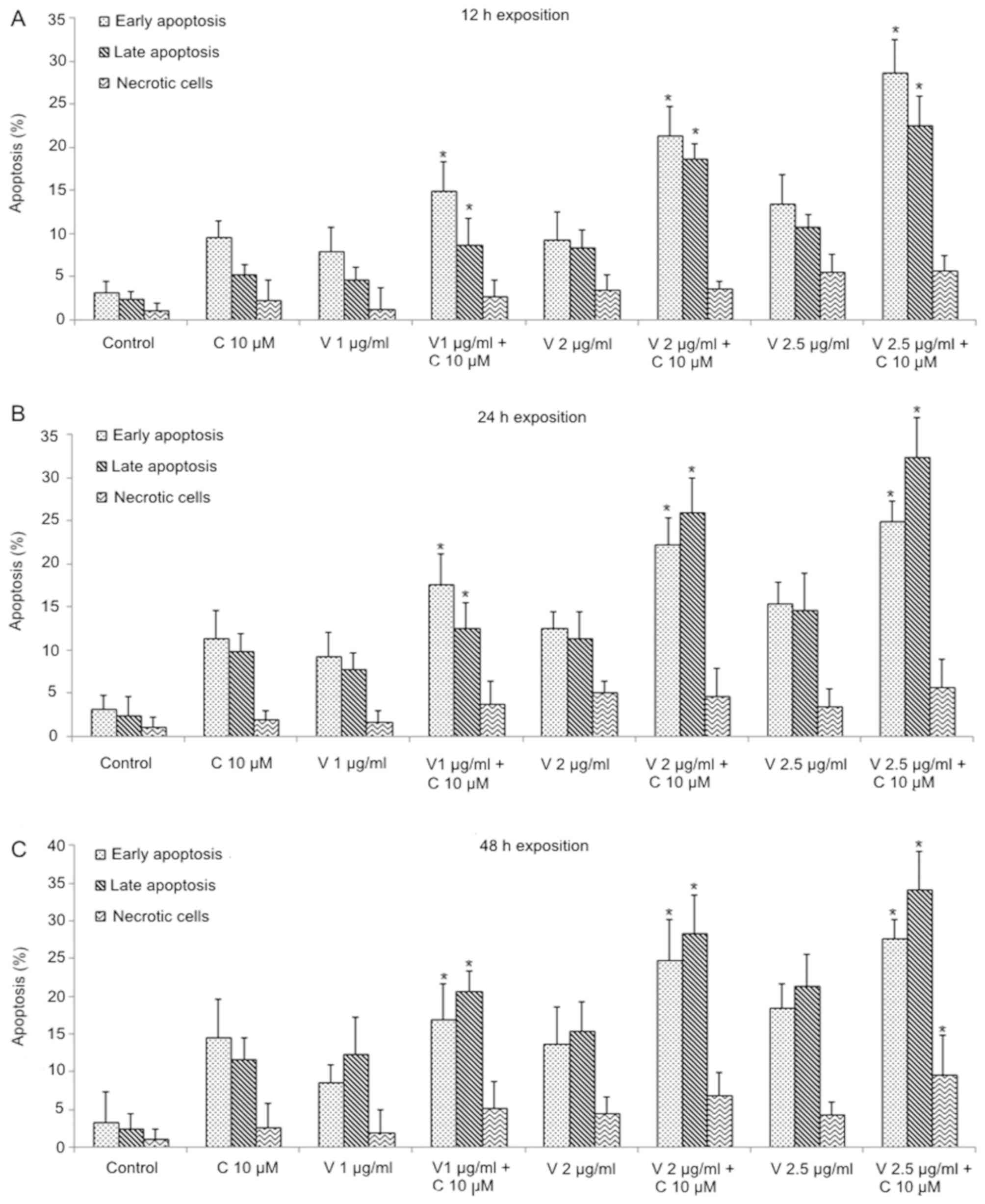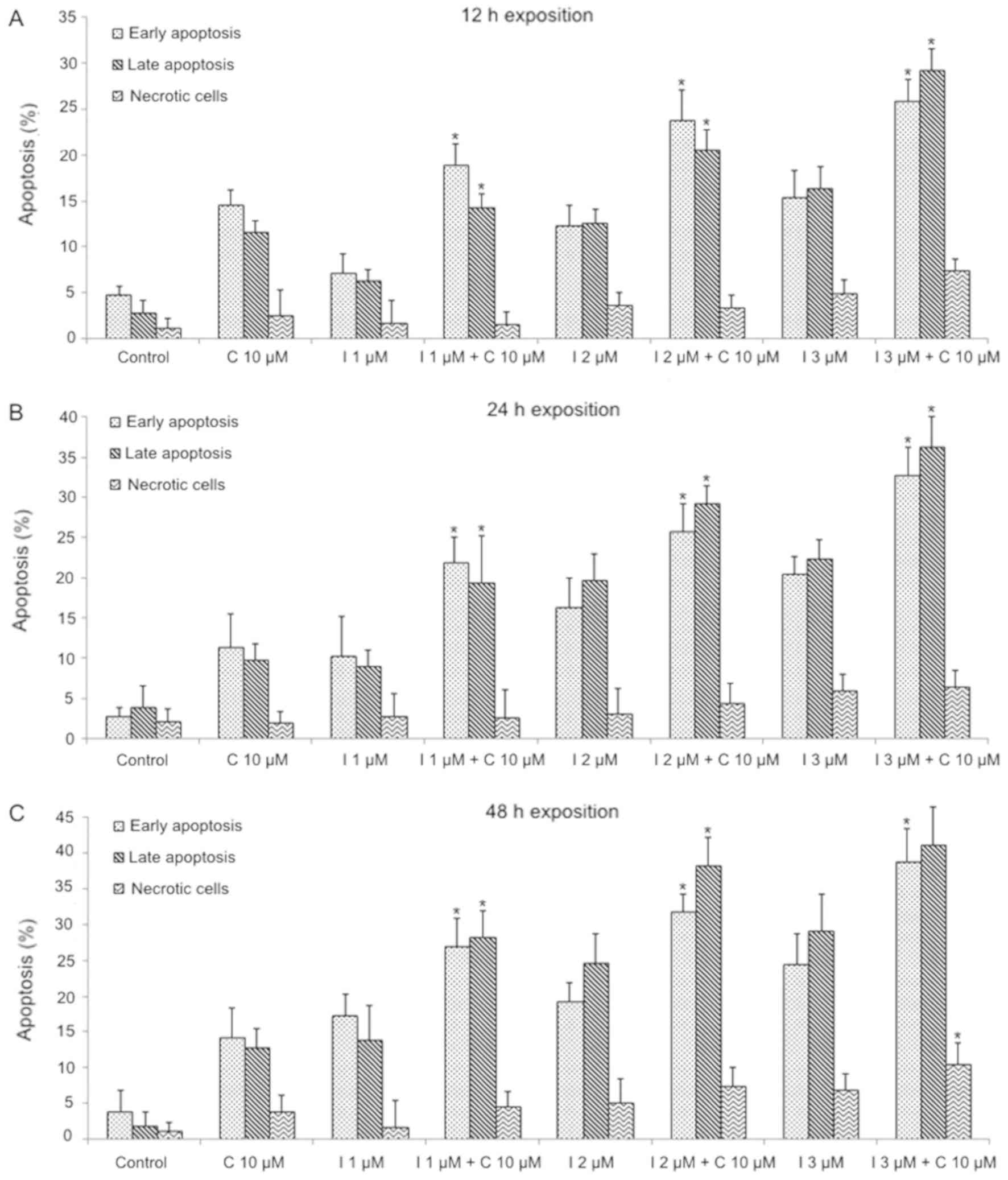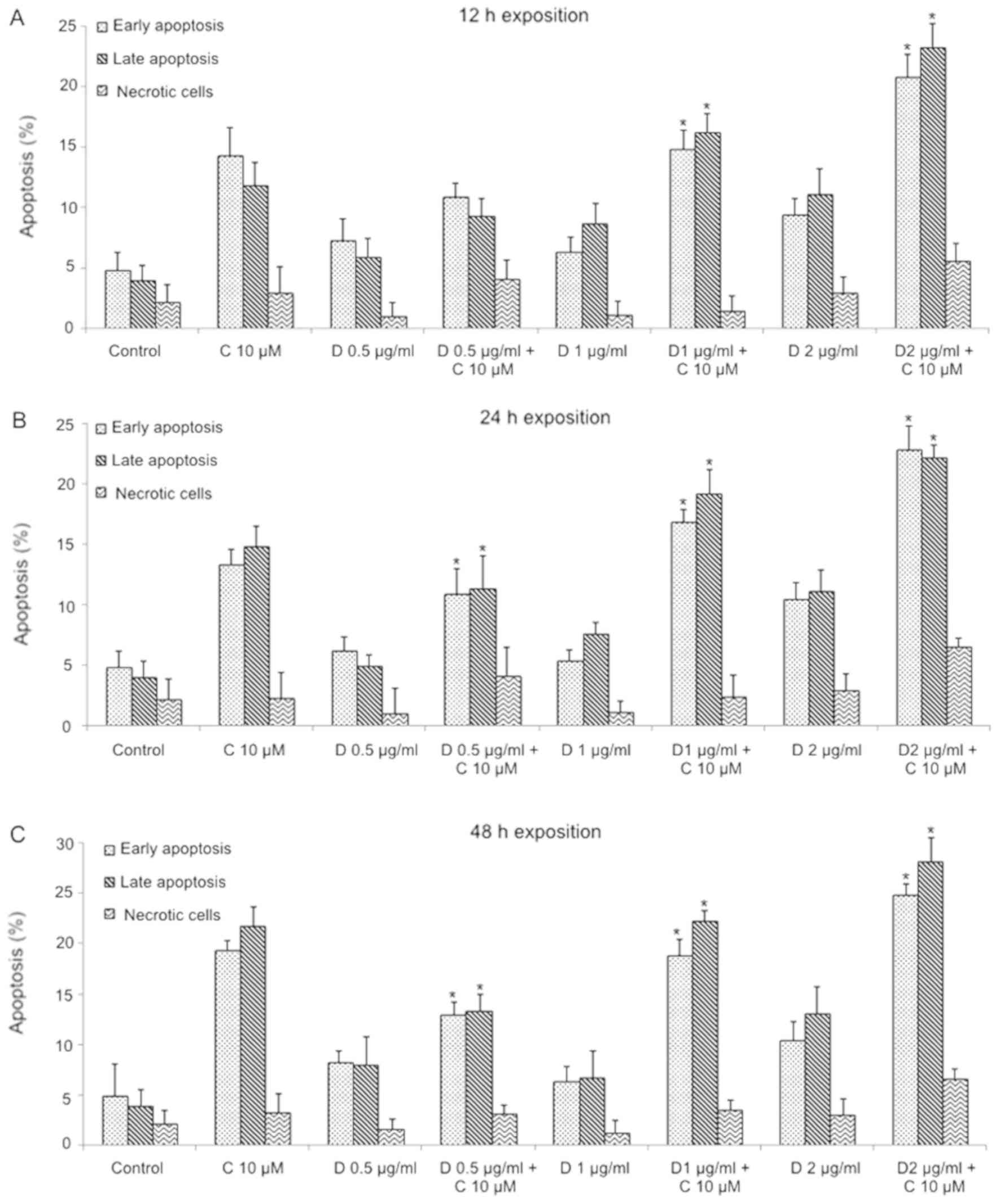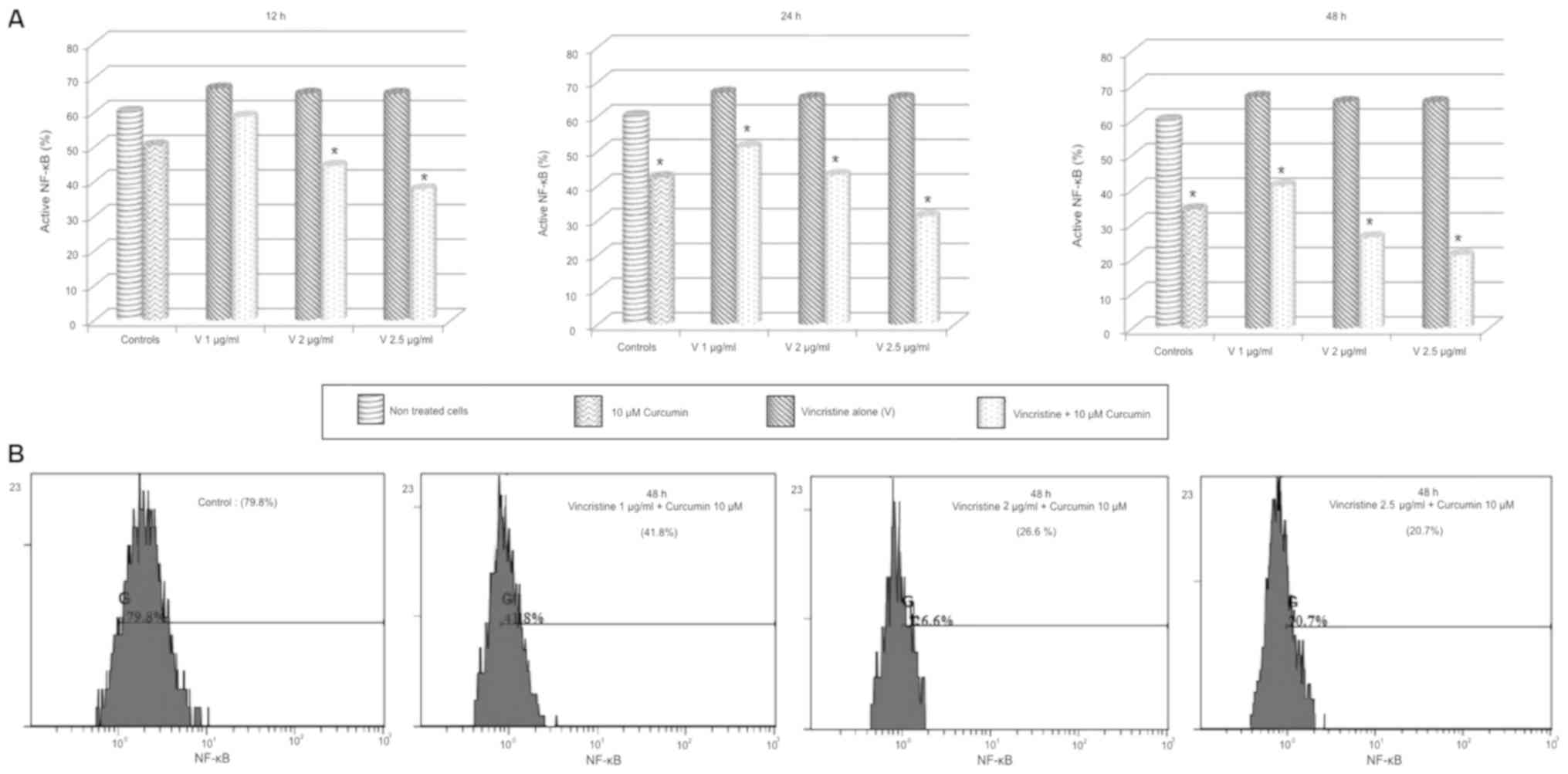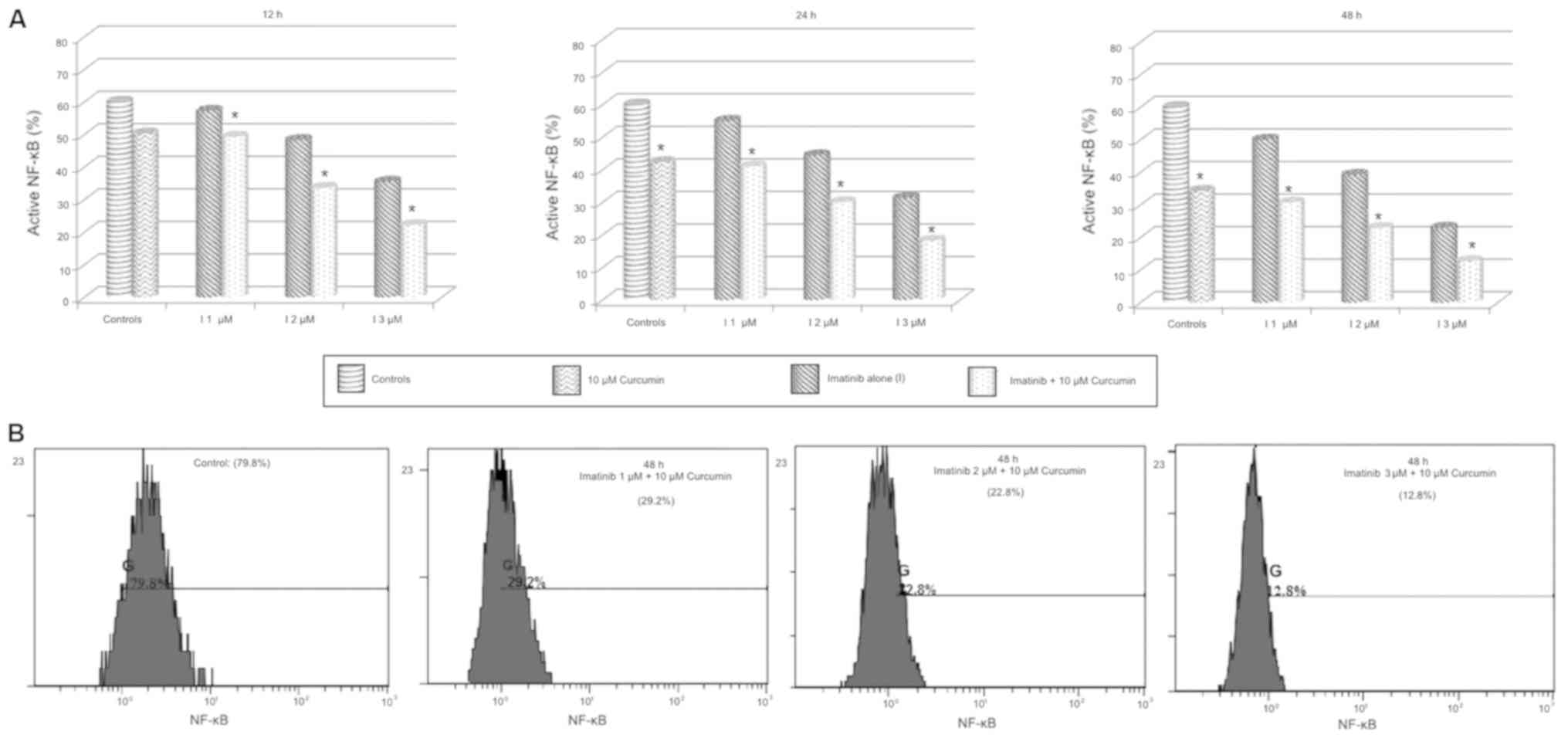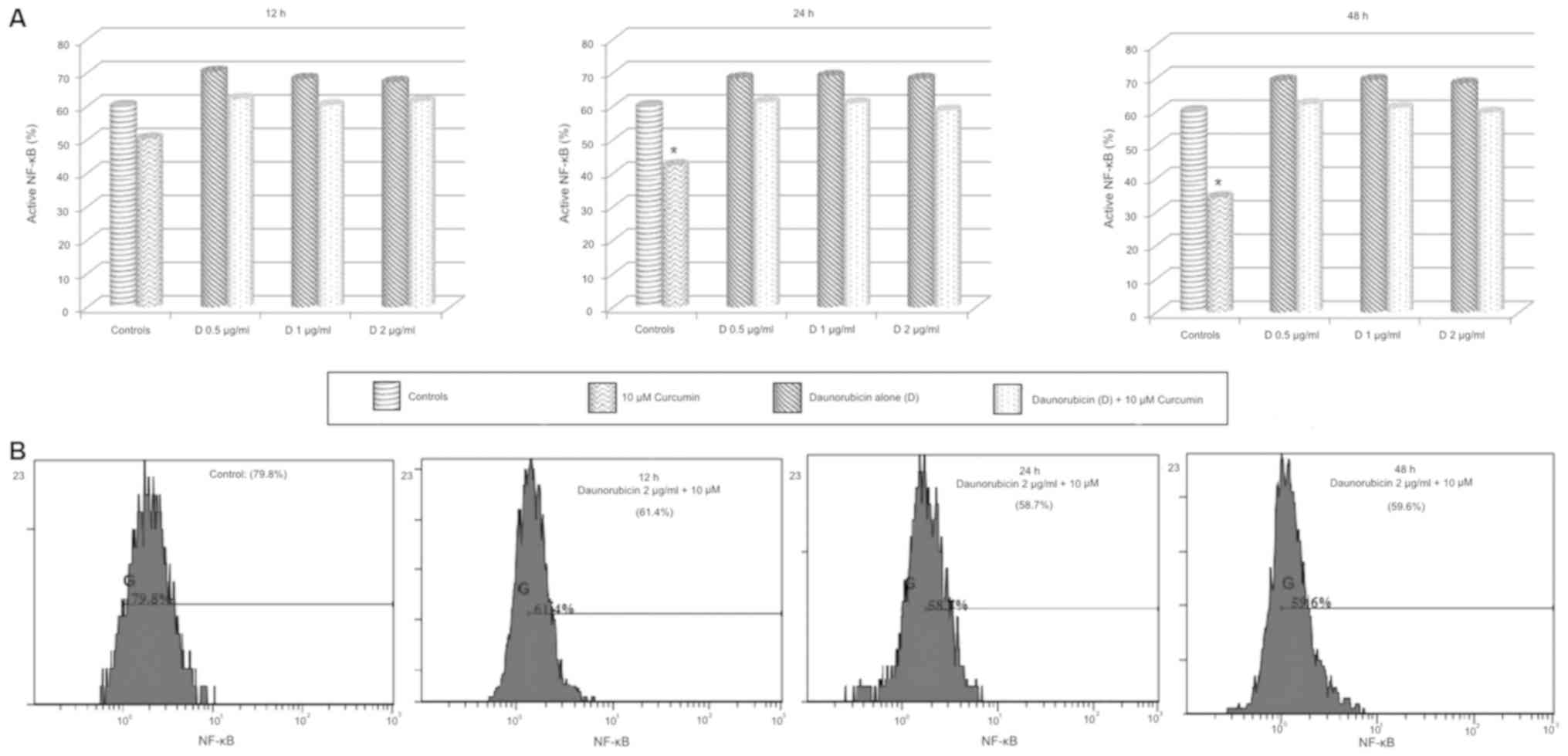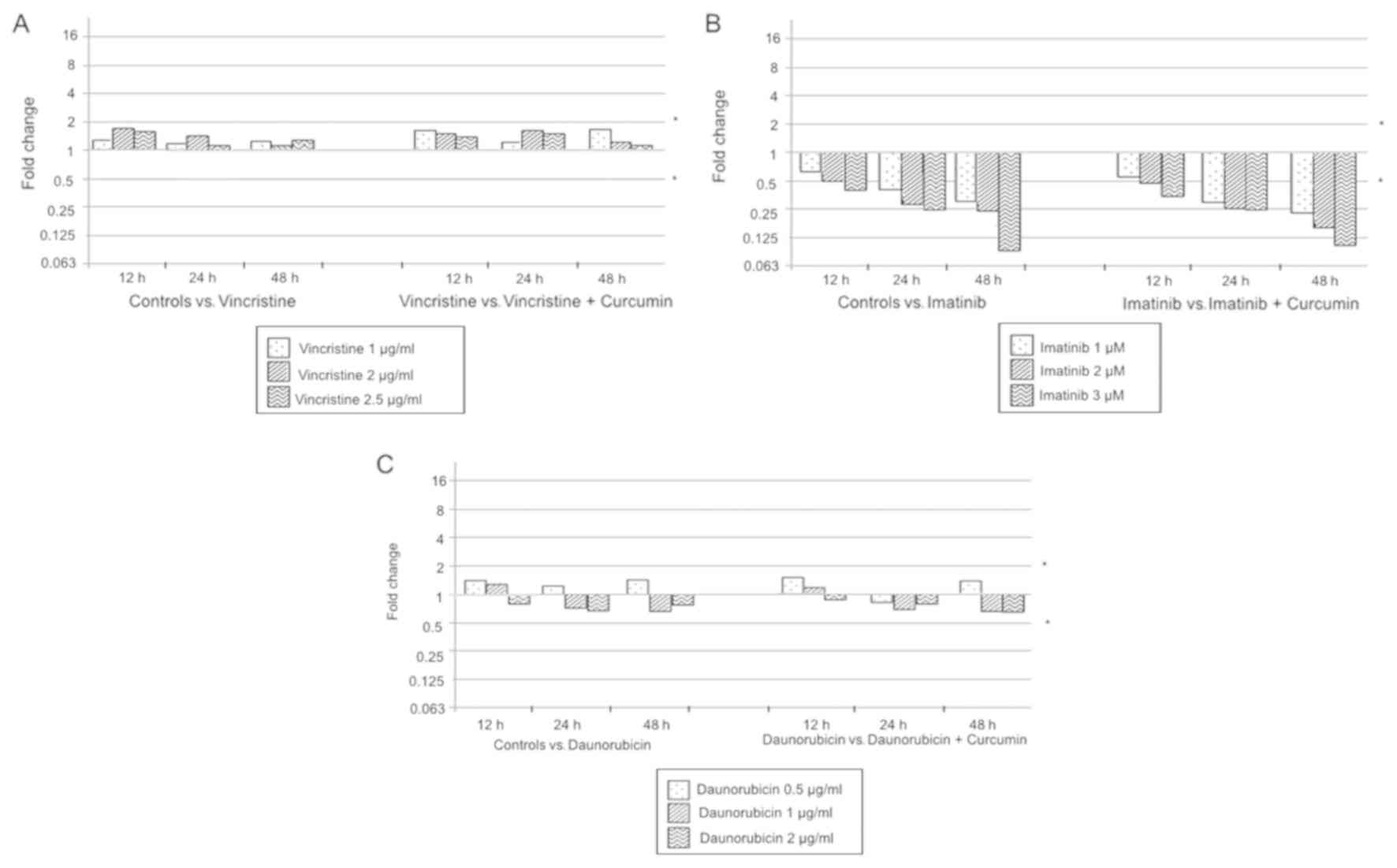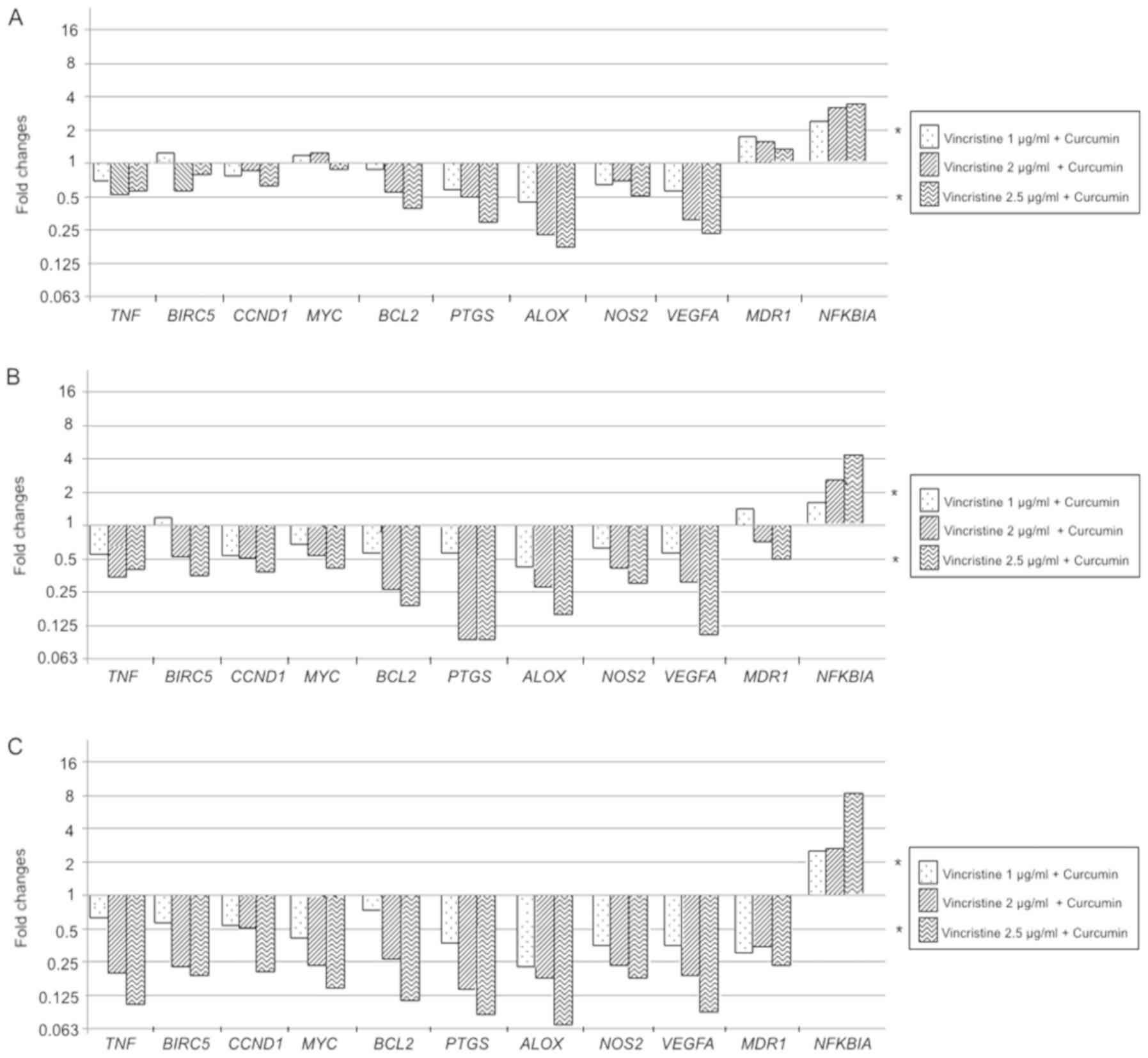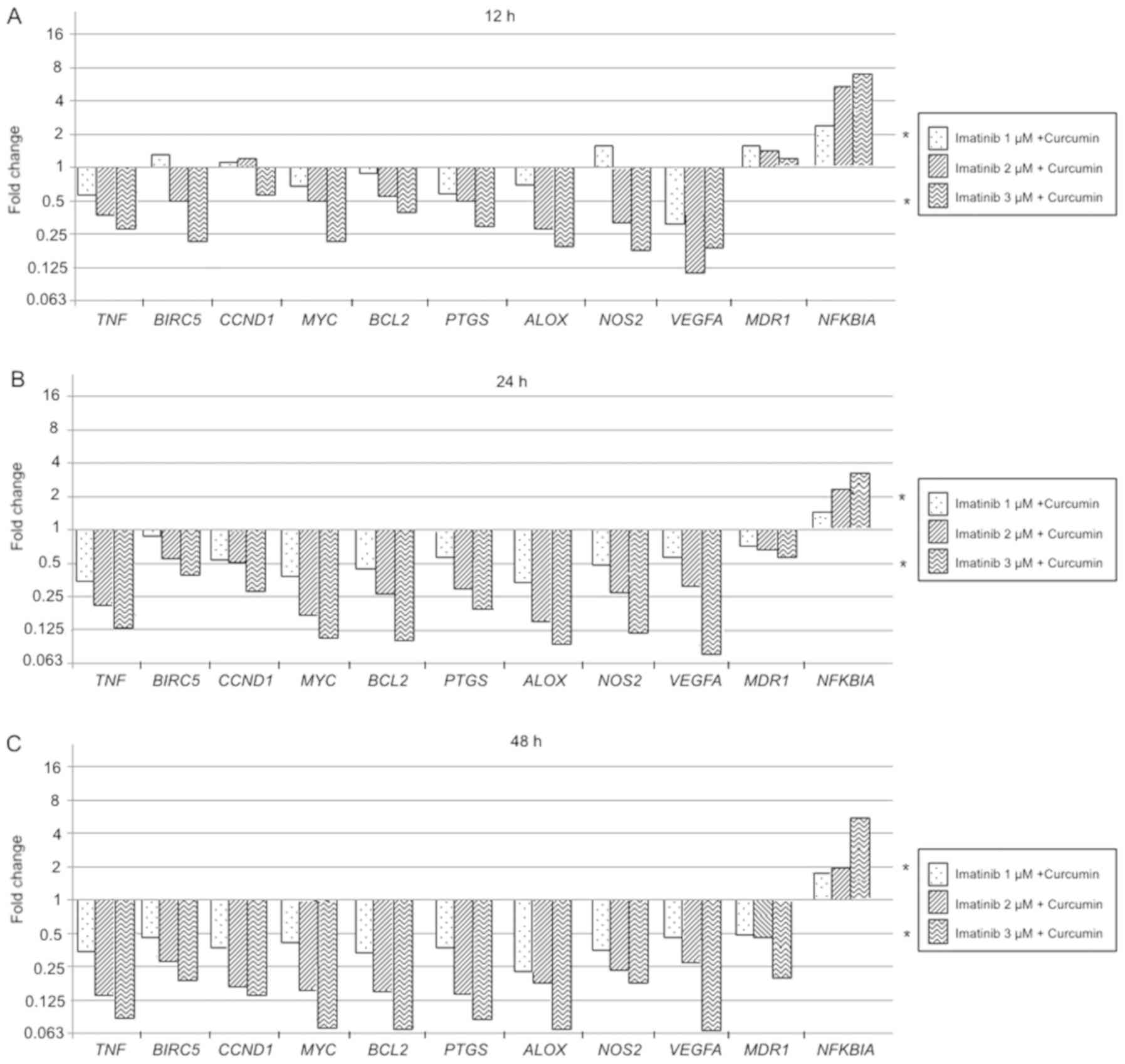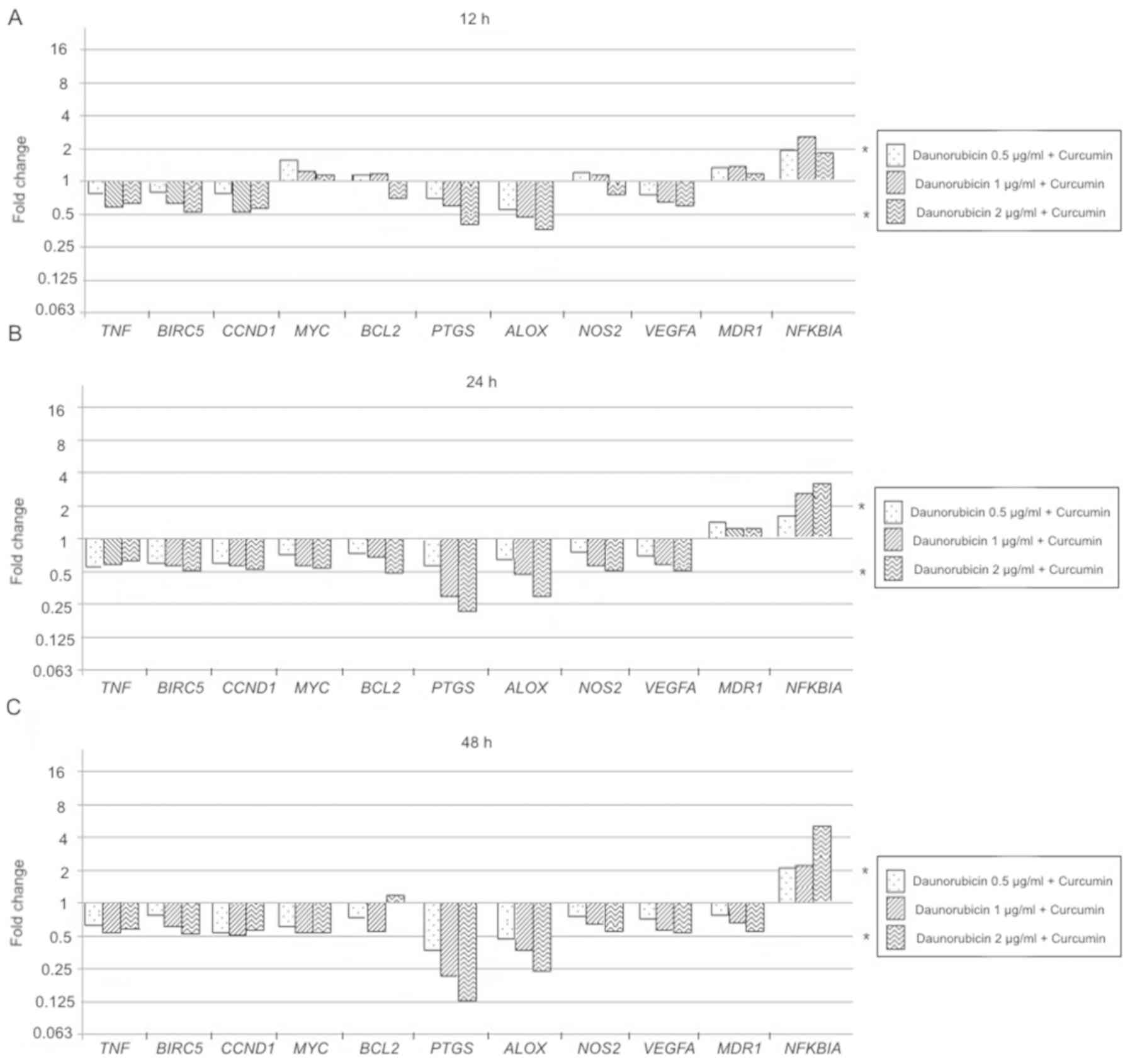In vitro effect of curcumin in combination with chemotherapy drugs in Ph+ acute lymphoblastic leukemia cells
- Authors:
- Published online on: April 2, 2019 https://doi.org/10.3892/ol.2019.10204
- Pages: 5224-5240
Abstract
Introduction
Philadelphia chromosome-positive acute lymphoblastic leukemia (Ph+ ALL) has the well-known mutation t(9;22)(q34q11) that causes the fusion of BCR and ABL1 genes (1). Ph+ frequency is less than 5% in ALL pediatric patients; although in this subgroup, the BCR-ABL oncogene encodes to a particular 190 kDa protein (p190) with deregulated tyrosine kinase activity that confers resistance to drugs and poor prognosis (2). BCR-ABL participates in leukemia initiation and progression by interacting with several signaling pathways; one of the most relevant is NF-κB activation (3). NF-κB is a transcription factor which regulates diverse genes involved in cell transformation, proliferation, inflammation, angiogenesis, invasiveness, and survival (4). NF-κB activation dependent of BCR-ABL signaling is modulated by CK2; this interaction enhances NF-κB nuclear translocation and transactivation, which modifies gene expression (5,6).
Vincristine, daunorubicin, and imatinib are some of the essential chemotherapy drugs for Ph+ ALL patients (7). Vincristine is a cell cycle specific drug that binds to tubulin, causing depolymerization of microtubules resulting in metaphase arrest and apoptosis induction (8). Daunorubicin is an anthracycline that inhibits topoisomerase II, inducing DNA damage and apoptosis (9). Imatinib is an essential drug used in Ph+ leukemias as target therapy, due to its inhibitory action of BCR-ABL signaling. A significant improvement in patient's outcome has been reported when standard chemotherapy is combined with imatinib (10). Despite the advances in treatment, standard chemotherapy effectiveness remains limited; the cure rate in Ph+ ALL pediatric patients using chemotherapy alone is only 30%, most of them commonly showed a reduced response and frequently relapse due to adverse reactions, toxicity or drug resistance development (11). Consequently, an adequate therapy where standard drugs are combined with multitarget compounds which develop minimal toxicity is of particular interest to improve treatment effectiveness. Curcumin (diferuloylmethane) is a therapeutic component of turmeric, which is obtained from the rhizome Curcuma longa; it has been used widely by some Asian countries in cooking and traditional medicine (12). Curcumin induces apoptosis, inhibits cellular transformation, proliferation, and invasion in a variety of cancer models in vitro and in vivo (13). The study of curcumin has become relevant due to its antitumoral potential (14). In vitro experiments have shown low toxicity of curcumin in normal cells (15). Furthermore, no adverse effects have been observed in clinical trials (16). Recent research had reported the anti-tumoral properties of curcumin due to the inhibition of proteins kinases and transcription factors, such as NF-κB (17). Besides being involved in the tumoral process, NF-κB downstream pathways also promote resistance to chemotherapy drugs, which reduces treatment effectiveness (18). Different studies showed that curcumin modulates the expression of several NF-κB regulated genes associated with tumoral processes, leading to a subsequent suppression of pro-tumoral pathways (19). According to the previous data, curcumin is capable to improve treatment efficacy. However, in human Ph+ ALL models, the therapeutic effect of curcumin and the molecular pathways involved in tumoral suppression remain unclear.
Due to the effect of curcumin in multiple protein kinases, we speculate that it can modulate BCR-ABL associated pathways, conducting to an increment of treatment efficiency. The purpose of this study was to evaluate the effect of vincristine, imatinib, and daunorubicin in combination with curcumin in the human OP-1 cell line. We determined the effect of the drugs alone and in combination with curcumin on cell viability, apoptosis degree, NF-κB activation, and gene expression.
Materials and methods
Reagents
Curcumin was acquired from Sigma-Aldrich (St. Louis, MO., USA). Vincristine, imatinib, and daunorubicin were provided by PiSa Farmacéutica (Guadalajara, México). Curcumin was dissolved in DMSO at a concentration of 10 µM and stored at −20°C. Chemotherapeutic drugs were dissolved in distilled water at a stock concentration, aliquoted and stored at −20°C. Each stock solution was diluted in culture medium to the final concentration before use.
Cell culture and treatment
OP-1 human cell line (RRID: CVCL_DG77) was gently provided by St. Jude Children's Research Hospital (Memphis, TN, USA), it was cultured in RPMI 1640 medium supplemented with 2 mM Glutamine, 100 U/ml penicillin-100 g/ml streptomycin and 15% FBS (Thermo Fisher Scientific, Inc., Waltham, MA, USA) in a humidified incubator at 37°C with an atmosphere of 5% CO2. Afterward, 1×106 OP-1 cells were treated at 12, 24 and 48 h with chemotherapy drugs alone and in combination with curcumin at concentration ranges of; curcumin (5–30 µM), vincristine (0.5–4 µg/ml), imatinib (0.5–5 µM), and daunorubicin (0.2–3 µg/ml), DMSO was used as the vehicle. Each evaluation was performed in triplicate, and the quality criteria for the experiments validation included coefficients of variation smaller than 10%.
Viability assay
To determine the cytotoxic effect of curcumin and chemotherapy drugs combination 7 ADD assay (Beckman Coulter, Inc., Brea, CA, USA) was performed. After the exposure to experimental treatments, cells were washed with PBS, centrifuged at 100 × g for 1 min and resuspended in PBS at a concentration of 1×106 cells/ml. Next, 100 µl of the solution was transferred to cytometry tubes and, 15 µl of anti-CD45/anti-CD19 and 100 µl of 7-ADD were added to each tube, homogenized and incubated for 20 min at room temperature in the dark. Subsequently, cells were resuspended in PBS. Briefly, 20,000 events were acquired in Gallios 10 Flow Cytometer (Beckman Coulter, Inc.) and analyzed in Flowing Software (Cell Imaging Core, FIN). Cells with 7ADD positive stain were considered non-viable, while live viable cells did not show 7ADD stain. Unstained cells were used as assay controls to exclude cell debris and auto-fluorescence. The IC50 of each drug was obtained from the dose-response curve using Compusyn software 1.0 (Combosyn Inc., Paramus, NJ, USA).
Apoptosis assay
To evaluate apoptosis, FITC Annexin V/Propidium Iodide Apoptosis Detection Kit (Pharmigen BD, Biosciences, San Jose CA, USA) was used. After experimental treatments exposure, cells were washed with cold PBS and resuspended in 1X Binding Buffer at a concentration of 1×106 cells/ml. 100 µl of the solution was transferred to cytometry tubes and, 5 µl of Annexin V FITC and 5 µl of Propidium Iodide (PI) were added, 15 µl anti-CD45/anti-CD19 were also used to select cell population, briefly, cells were homogenized with vortex, and incubated at room temperature for 15 min in the dark. Then 400 µl of 1X Binding Buffer was added. 20,000 cells were analyzed in Gallios 10 flow cytometer (Beckman Coulter, Inc) and data were interpreted in Flowing Software (Cell Imaging Core, Turku, Finland). The assay was evaluated according to the next criteria: Annexin V(−)/PI(−)=live-viable cells; Annexin V(+)/PI(−)=early apoptosis stage; Annexin V(+)/PI(+)=late apoptosis stage; Annexin V(−)/PI(+)=necrotic cells. Untreated cells stimulated with 1 mM Camptotepcin (5 h, 37°C) were used as positive controls; untreated and unstimulated cells were used as negative controls; unstained cells, unstained treated with curcumin cells, stained cells with Annexin V alone and stained with PI alone were used as compensation controls.
NF-κB detection
To determine the activation/transactivation potential of NF-κB after treatment; phosphorylated p65 subunit was analyzed using the Phospho-Epitopes Exposure kit (Beckman Coulter, Inc) and anti-NF-κB p65pS529-PE (Miltenyi Biotec GmbH, Bergisch Gladback, Germany). After experimental treatments, cells were fixed with PerFix Fixative Reagent an incubated for 10 min at room temperature. Next, cells were permeabilized using Perfix Permeabilizing reagent for 5 min at 37°C in a water bath. Thereafter, a premixed of 50 µl staining reagent, 2 µl anti-NF-κB p65pS529-PE (dilution 1:50), 15 µl anti-CD45/anti-CD19 were added to each tube and immediately incubated at room temperature for 30 min in the dark. Once the incubation time has passed, cells were washed with 3 ml 1X wash reagent, centrifuged at 300 × g for 5 min and the supernatant was completely discarded by aspiration. The cells pellet was resuspended in 0.5 ml of the 1X wash reagent. Data acquisition was carried out in Gallios 10 Flow Cytometer (Beckman Coulter, Inc) considering 20,000 events and analyzed in Flowing Software (Cell Imaging Core, FIN). Stained cells with anti-NF-κBp65 were considered active. To calculate the activation percentage of NF-κB, a negative control absent from the anti-NF-κBp65 was used; cells stimulated with TNF were considered as positive control.
Gene expression
Changes in the expression of BCR-ABL1 and genes regulated by NF-κB were evaluated. Genes were selected considering its particular role in ALL processes as described below: Proliferation, CCND1, TNF, and MYC; antiapoptosis BCL2, BIRC5, and PTGS; invasivity ALOX, NOS2, and VEGFA; drug resistance MDR1; NF-κB inhibitor NFKBIA. After treatment, the cells were washed with PBS and centrifuged at 100 × g for 2 min at room temperature, next RNA isolation was performed using TRIzol® Reagent (Thermo Fisher Scientific, Inc.) according to manufacturer's instructions. Isolated RNA was treated with DNase1 amplification grade (Thermo Fisher Scientific, Inc.) and reverse transcription PCR (RT-PCR) was performed using 1 µg total RNA and the High Capacity cDNA Reverse Transcription kit (Thermo Fisher Scientific, Inc.) in a GeneAmp PCR System 9700 thermal cycler (Thermo Fisher Scientific, Inc.) with the following conditions 25°C/25 min, 37°C/120 min, 85°C/5 min, and infinite hold at 4°C. Real-Time quantitative PCR (qRT-PCR) was performed using 1 µl of cDNA, TaqMan® Gene Expression Master Mix and TaqMan® Gene Expression Assays with FAM MGB fluorophore-quencher system for each gene (Thermo Fisher Scientific, Inc.), the experimental samples were evaluated in duplicate. The next TaqMan assays were used in this study: BCRABL1, Hs03024844_ft; CCND1, Hs00765553_m1; TNF, Hs99999043_m1; MYC, Hs00153408_m1; BCL2, Hs00608023_m1; BIRC5, Hs00153353_m1; PTGS2, Hs00153133_m1; ALOX5, Hs01095330_m1; NOS2, Hs01075529_m1; VEGFA, Hs00900055_m1; MDR1, Hs00184500_m1; NFKBIA, Hs00153283_m1; GUSB, Hs00939627_m1; cat. no. 4331182 (Thermo Fisher Scientific, Inc.). qRT-PCR was performed in a 7900 HT Fast Real-Time PCR System linked to SDS 2.4 software (Thermo Fisher Scientific, Inc.), cycling conditions were: 50°C/2 min, 95°C/10 min, 95°C/15 sec and 60°C/1 min (40 cycles). Gene expression was calculated by relative quantification using the 2ΔΔCq method (20), β-glucuronidase (GUSB) housekeeping gene was evaluated as constitutive control and chemotherapy drugs alone groups as a calibrator.
Combinations analysis
Interaction effect of the chemotherapy drugs and curcumin was evaluated by the isobologram method using the Compusyn Software (Compusyn, Inc. Paramus, NJ, USA). The combination index (CI) of each treatment was calculated according to the Chou & Talalay's median effect equation, based on the dose-effect curve for experimental combination and their respective IC50 (21). The CI value indicates the interaction of treatment combinations as follows: CI<0.9, synergism; CI between 0.9–1.1, additive; CI>1.1, antagonism. Dose reduction index (DRI) was calculated according to the CI of each combination treatment, DRI indicates the level that a drug can be reduced and will continue producing a similar individual effect in a synergistic combination (22).
Statistical analysis
Significant differences were analyzed using the SPSS Software (SPSS, Inc., Chicago, IL, USA). Data were reported as the mean value ± standard deviation. Comparison between groups was statistically evaluated using one-way ANOVA. When intragroup variance was similar Tukey's test was performed, Dunnett's T3 was used when the variance was different. P<0.05 was considered to indicate a statistically significant difference.
Results
Cytotoxic effect of treatments
The cytotoxic effect of imatinib, vincristine, and daunorubicin alone and in combination with curcumin in OP-1 cell line was determined by the 7ADD assay. After 12, 24 and 48 h of treatment, IC50 values for the chemotherapy drugs, were respectively as follows: curcumin, 24.6, 21.5 and 14.7 µM; vincristine, 4, 3.4 and 3 µg/ml; imatinib, 4.2, 3.2 and 2.4 µM; daunorubicin, 2.4, 2.4 and 2.3 µg/ml. This data showed that curcumin, vincristine, and imatinib induce cytotoxicity to OP-1 cell line in a dose-and time-dependent manner (P<0.05), while daunorubicin showed cytotoxic effect just in a dose-dependent manner (P<0.05; Fig. 1). According to these results and in-vitro assays parameters, three concentrations of each chemotherapy drug were selected and combined with 10 µM of curcumin for similar treatment. The cytotoxic effect was found to be greater for each combination compared to individual chemotherapy drugs effect (P<0.05; Fig. 2).
Evaluation of treatment interaction
To evaluate the effect of combined treatments, combination index (CI) values were generated from the IC50 ratio of individual drugs and its combination with curcumin; CI values indicate the interaction degree between curcumin with chemotherapy drugs. This data was represented in normalized isobolograms and fractional affected-combination index plots (Fa-CI) using Compusyn Software 1.0 (Combosyn Inc., Paramus, NJ, USA).
The combination of vincristine with 10 µM curcumin at 12 h, showed a dose-dependent pattern; 1 µg/ml vincristine + curcumin exerted a nearly additive effect, while 2 and 2.5 µg/ml vincristine + curcumin yielded slight and moderate synergism respectively. Similarly, combinations at 24 h treatment, exhibit a dose-dependent pattern; 1 µg/ml vincristine + curcumin resulted in a nearly additive effect, however, 2 and 2.5 µg/ml vincristine + curcumin effects were enhanced, pointing to moderate synergism and complete synergism respectively. At 48 h treatment, the effects significantly increase compared to 12 and 24 h, and showed a dose-dependent pattern as well; all vincristine doses showed a synergistic effect; 1, 2 and 2.5 µg/ml of vincristine + curcumin had a slight, moderate and complete synergism respectively. In general, the combination of vincristine + curcumin produces a more potent effect than each agent alone; this combination exhibited a dose-and time-dependent pattern, shifting from nearly additive interaction to synergism (Table I; Fig. 3).
Imatinib + 10 µM curcumin at 12 h produces the next results; 1 µM imatinib + curcumin exhibit a nearly additive effect, whereas 2 and 3 µM imatinib + curcumin showed a moderate synergism. Imatinib + 10 µM curcumin at 24 h exposition produces synergistic effects at different degrees; 1 µM imatinib + curcumin, slight synergism; 2 µM imatinib + curcumin, moderate synergism; 3 µM imatinib + curcumin, synergism. Imatinib + curcumin after the 48 h exposition also generates a synergistic effect in all combinations; 1 µM imatinib + curcumin showed a moderate synergism, while 2 and 3 µM imatinib + curcumin produced a complete synergism effect. In general, imatinib + curcumin effect was synergistic and increases in a dose-and time-dependent manner (Table I; Fig. 4).
The combination of daunorubicin with 10 µM curcumin resulted in a moderate antagonism effect when 0.5 µg/ml daunorubicin was used at all exposition times. Combination of 1 µg/ml daunorubicin + curcumin generated a slight antagonism at 12 h, while the rest of the combinations produced a nearly additive effect. Although, 2 µg/ml daunorubicin + curcumin produces a nearly additive effect at all exposition times. According to these results, daunorubicin + curcumin treatment showed an additive effect only at doses greater than 1 µg/ml daunorubicin and exposed for more than 24 h (Table I; Fig. 5).
Experimental induction of apoptosis
In order to evaluate the apoptosis degree induced by chemotherapy drugs alone compared to chemotherapy drugs + curcumin in OP-1 cells; FITC Annexin V/PI assay was performed. Vincristine + curcumin combinations induced a significant increment of apoptotic cells compared to both agents alone (P<0.05). An early apoptotic stage was principally observed in this combination at 12 h, whereas at 24 and 48 h exposition, late apoptotic cells stage showed a significant increase (P<0.05; Fig. 6). The combination of imatinib + curcumin produced a significative increase on apoptosis, compared to each agent alone (P<0.05); the apoptosis degree increments significantly from early apoptosis to late apoptosis in a dose-dependent manner (P<0.05), 3 µM Imatinib + curcumin induced a high percentage of late apoptosis in all exposition times; moreover, necrotic cells significantly increase in the combination compared to controls at 48 h (P<0.05; Fig. 7). Daunorubicin + curcumin combination showed a significant increase in apoptosis than daunorubicin alone using 1 and 2 µg/ml daunorubicin + curcumin (P<0.05), this increment did not change due to exposition time (Fig. 8).
NF-κB activity after treatment
To determine the activation/transactivation potential of NF-κB in OP-1 cells after exposition to chemotherapy drugs alone and in combination with curcumin, phosphorylated p65 subunit in ser529 was evaluated. 10 µM curcumin significantly reduced NF-κB activity at 24 and 48 h in all experiments (P<0.05), while individual treatment of vincristine showed a higher NF-κB activity compared to control groups; this increment was not statistically significant and it did not change with dose or exposition time increments. Combination of 1 µg/ml of vincristine + curcumin decreased the NF-κB activity compared to vincristine alone at 24 and 48 h, these changes were statistically significative in a dose-and time-dependent manner (P<0.05). In all experiments, 2 and 2.5 µg/ml vincristine + curcumin reduced the NF-κB activity compared to vincristine alone in a dose-and time-dependent manner (P<0.01; Fig. 9). Imatinib alone treatment significantly reduced NF-κB activity in a dose-and time-dependent manner (P<0.05), the combination of imatinib + curcumin compared to imatinib alone showed a significantly reduced activity of NF-κB in all experiments, these changes exhibit a dose-and time-dependent pattern (P<0.05–0.01; Fig. 10). Daunorubicin alone treatment increased NF-κB activity compared to control groups, although this increment was not significative. As well, daunorubicin + curcumin treatment did not produce any significative change of NF-κB activity (Fig. 11).
Expression of BCR-ABL1 fusion gene in experimental conditions
BCR-ABL1 gene was detected in OP-1 cell line and its expression level was measured after each experimental treatment. Relative gene expression level significantly decreased only in imatinib-treated cells in a dose and time-dependent manner. Vincristine and daunorubicin did not induce any change in BCR-ABL1 expression level compared to controls. As well no significant differences were observed when each chemotherapy drug was combined with curcumin (Fig. 12).
Effect of combination treatments on the expression of NF-κB regulated genes
Gene expression was evaluated in OP-1 cells after the exposition to chemotherapy drugs alone as the calibrator and chemotherapy drugs + curcumin as the target group.
In the evaluation of vincristine + curcumin compared to vincristine alone treatments, following results are reported; at 12 h exposition BCL2, PTGS, ALOX, VEGFA significantly reduce its expression, while NFKBIA increment it; these changes showed a dose-dependent pattern (P<0.05). At the 24 h exposition, a decrease in the expression of BIRC5, CCND1, MYC, BCL2, PTGS2, ALOX, NOS2, and VEGFA in a dose-dependent manner is observed, as well TNF showed an expression decrement, but it was not dependent of vincristine dose (P<0.05). Similarly to 12 h experiments, NFKBIA showed an increased expression in a dose-dependent manner at 24 h (P<0.05). When experiments were performed at 48 h exposition MDR1 showed a downregulated expression not associated to vincristine dose (P<0.01), NFKBIA continues showing a dose-dependent overexpression (P<0.01), and the expression of all other genes significantly decreased in a dose-dependent manner (P<0.01). In general, vincristine + curcumin modulated expression of selected genes in a dose-and time-dependent manner (Fig. 13).
Imatinib + curcumin compared to imatinib alone treatment effect on genes expression is reported below: At 12 h exposition TNF, BIRC5, MYC, BCL2, PTGS2, ALOX, and NOS2 were significantly downregulated in a dose-dependent manner (P<0.05), VEGFA showed a significant decrement of gene expression that was not related to imatinib dose (P<0.05), while NFKBIA was overexpressed according to imatinib dose increment (P<0.05). After 24 h of exposure, MDR1 and NFKBIA showed a dose-dependent significant overexpression (P<0.05), but NFKBIA overexpression was smaller compared to 12 h exposure. The rest of the evaluated genes showed a significant expression reduction in a dose-and time dependent manner (P<0.05). The 48 h evaluation showed a significant decrease of MDR1 expression in a dose-and time dependent-manner (P<0.01), NFKBIA was overexpressed just at 3 µM imatinib (P<0.05), in all the rest of the evaluated genes the expression was downregulated in a dose-dependent manner (P<0.01). In general, imatinib combined with curcumin produce changes in the expression of evaluated genes in a dose-and time-dependent manner (Fig. 14).
Daunorubicin + curcumin treatment effect compared to daunorubicin alone, showed the next results: the 12 h evaluation resulted in a significant decrease of PTGS and ALOX expression at 1 and 1–2 µg/ml respectively (P<0.05), while NFKBIA showed an overexpression only in treatment with 1 µg/ml daunorubicin + curcumin (P<0.05). Similarly, experiments at 24 and 48 h treatment exposition only showed significant decrement of expression in PTGS and ALOX in a dose-dependent manner (P<0.05), while NFKBIA was significantly overexpressed according to daunorubicin dose increment (P<0.05; Fig. 15).
Discussion
In the current study, the effect of curcumin in combination with chemotherapeutic drugs in OP-1 cell line was investigated. Curcumin antitumoral properties have been evaluated in different types of cancer cells (23), and a vital role in NF-κB activity modulation has been reported (24). Our results show that curcumin potentiates the anti-leukemia effect of vincristine and imatinib in a dose and time-dependent manner, while curcumin + daunorubicin effect did not significantly change. The decrease in NF-κB activity caused by the experimental treatments was associated with the anti-leukemia effect increment. We could not find any evaluation performed in a Ph+ ALL model, similar to those made in this study.
The results revealed that each tested agent induces cytotoxicity and its combination with curcumin increment it significantly. Previously, this cytotoxic effect was reported in ALL, considering only the dose of the drugs (25–28) but not the exposition of time as we did.
Vincristine + curcumin combination produce an effect in the range of nearly additive to synergistic. We did not find any other report of this interaction in a Ph+ ALL model, but we suggest that curcumin could prolong cellular accumulation of vincristine in cancer cells (29), increasing the anti-leukemia effect. Similarly, imatinib + curcumin exhibit an interaction effect varying from nearly additive to synergistic. Previously, was demonstrated the efficacy of this combination in ALL (25) cells in vitro and in vivo, but they did not perform interaction analysis as we did. In daunorubicin + curcumin combination, interaction response from moderate antagonistic to nearly additive was observed. We suppose that daunorubicin anti-leukemia activities strongly coincide with those generated by curcumin (30) so that an enhancing effect is not produced, and instead an antagonistic/additive effect is observed. Again, previous reports of this interaction in Ph+ ALL model are not available.
Our results reveal a significant apoptosis induction increment produced by chemotherapeutic drugs + curcumin compared to each individual agent. In agreement with our study, Guo et al (2015) reported an apoptosis increase using 1 µM imatinib + curcumin (25). However, they did not evaluate the drug dose and exposition time effect. Furthermore, we report for the first time a pro-apoptotic effect of vincristine/daunorubicin + curcumin in a Ph+ ALL model using Annexin V/PI staining. Previously, caspase-3 activation was measured to report that the combination of vincristine/daunorubicin with curcumin augments apoptosis in REH cells (28).
Considering that curcumin is involved in the suppression of NF-κB activity by inhibiting different kinases, Ser529p65 phosphorylation was evaluated. OP-1 cells treated with vincristine + curcumin exhibit a decrease in NF-κB activation compared to vincristine alone. Pimentel-Gutiérrez et al (2016) reported an increment of NF-κB activation in REH cells treated with vincristine (28), but unlike our study, they evaluated the Ser536p65 phosphorylation, that is not associated with the BCR-ABL activity. We suggest that the NF-κB activity decrease observed in our results is principally due to curcumin activity and exposition time; this can be explained by the findings reported in Das & White study (1997), where they also observed NF-κB activation (31). Imatinib + curcumin induce a significant decrease in NF-κB activation compared to imatinib alone. Our results are in accordance with the data reported by Demiray et al in adenoid cystic carcinoma (32). We could not find any study which evaluates the imatinib + curcumin effect on NF-κB activity in a Ph+ ALL model. Daunorubicin + curcumin did not produce any significant change in NF-κB activities compared to daunorubicin alone; thus we suggest curcumin activities could be masked by daunorubicin functions.
The BCR-ABL1 gene expression level is a gold standard tool used in diagnosis and follow-up of pediatric patients (6). We performed such measurement in each OP-1 cells experimental conditions that result as expected: a higher level of expression in untreated cells and decreased gene expression only in imatinib-treated cells. Clearly, curcumin did not induce significant changes in BCR-ABL1 gene expression, but its addition provided increased treatment effectivity based on evidence obtained from NF-κB activation due to BCR-ABL presence, as well as the rest of biological parameters measured (NF-κB regulated genes expression, proliferation, and apoptosis). These explain the synergistic effect of imatinib + curcumin combination, and its difference with vincristine or daunorubicin combination treatments. This information is described in an integrated proposal diagram in Fig. 16.
Vincristine/imatinib + curcumin induce significant decrease in the expression of CCND1, TNF, MYC, BCL2, BIRC5, PTGS, ALOX, NOS2, VEGFA, and MDR1 genes; these decreases are explained due to the NF-κB activity inhibition. As well, both combinations induce NFKBIA overexpression; we proposed that while NF-κB activity decreases the NKBIA gene, increments its molecular activity. Daunorubicin + curcumin induces only significant downregulation of ALOX and PTGS genes and overexpression of NFKBIA gene; according to the NF-κB activity status in this combination, we suggest that these changes could be associated only to curcumin effect.
In conclusion, curcumin potentiates the anti-leukemia effect of vincristine and imatinib in a dose-and time-dependent manner. Otherwise, the combination of curcumin with daunorubicin did not produce any improvement (Fig. 16). The described results are of clinical importance and suggest that curcumin could be a promising agent. The treatment efficacy could be potentiated in Ph+ ALL with bad prognosis by combining these drugs with curcumin. Further studies are necessary to evaluate curcumin effect in combination with more chemotherapy drugs of ALL standard scheme. Finally, further studies are necessary to assess if the anti-leukemia effect of chemotherapy drugs-curcumin interactions would be observed in alternative fusion-genes cell line models related to leukemia.
Acknowledgements
The authors would like to thank the St. Jude Children's Research Hospital (Memphis, TN, USA) for providing the OP-1 cell line and Dr Fernando Sánchez-Zubieta (Pediatric Hematology and Oncology Service, Pediatric Division, Civil Hospital of Guadalajara, Jalisco, México).
Funding
The present study was partially supported by the National Council of Science and Technology (CONACYT, México, Grant no. 375707-305844-2014), PhD Molecular Biology Doctoral Program (University of Guadalajara, Grant no. 208522618-2014) and Medical Genetics Residency Program (University of Guadalajara, Grant no. 237181-2017).
Availability of data and materials
The datasets used and/or analyzed during the current study are available from the corresponding author on reasonable request.
Authors' contributions
UFSB participated in study design, cell culture and all performed experiments, analyzed and interpreted the results and was a major contributor in writing the manuscript. LBM participated in study design, analysis and interpretation of the results, was involved in drafting the manuscript and revising it critically for important intellectual content. LMM participated in cell culture and all performed experiments, and contributed to the analysis and the interpretation of the experimental data. ETA, participated in experimental design, analyzed and interpreted the results. SABJ participated in interpreting the results, and drafting the manuscript. CCBB performed flow cytometry experiments. JRCR made substantial contribution to the conception of the study, and was involved in drafting the manuscript and revising it critically for important intellectual content. ACR coordinated the study, made substantial contribution to its conception and design, analysis and interpretation of the experimental data, was involved in drafting the manuscript and revising it critically for important intellectual content given final approval of the version to be published.
Ethics approval and consent to participate
The present study was performed in accordance with the declaration of Helsinki and was approved by the local ethics committee O.P.D. Civil Hospital of Guadalajara and University of Guadalajara (Guadalajara, Jalisco, México).
Patient consent for publication
Not applicable.
Competing interests
The authors declare that they have no competing interests.
References
|
Thomas DA: Philadelphia chromosome positive acute lymphocytic leukemia: A new era of challenges. Hematology Am Soc Hematol Educ Program. 435–443. 2007. View Article : Google Scholar : PubMed/NCBI | |
|
Mishra S, Zhang B, Cunnick JM, Heisterkamp N and Groffen J: Resistance to imatinib of bcr/abl p190 lymphoblastic leukemia cells. Cancer Res. 66:5387–5393. 2006. View Article : Google Scholar : PubMed/NCBI | |
|
Cilloni D and Saglio G: Molecular pathways: BCR-ABL. Clin Cancer Res. 18:930–937. 2012. View Article : Google Scholar : PubMed/NCBI | |
|
Hoffman A and Baltimore D: Circuitry of nuclear factor kappaB signaling. Immunol Rev. 210:171–186. 2006. View Article : Google Scholar : PubMed/NCBI | |
|
Mishra S, Pertz V, Zhang B, Kaur P, Shimada H, Groffen J, Kazimierczuk Z, Pinna LA and Heisterkamp N: Treatment of P190 Bcr/Abl lymphoblastic leukemia cells with inhibitors of the serine/threonine kinase CK2. Leukemia. 21:178–180. 2007. View Article : Google Scholar : PubMed/NCBI | |
|
Morotti A, Carrà G, Panuzzo C, Crivellaro S, Taulli R, Guerrasio A and Saglio G: Protein kinase CK2: A targetable BCR-ABL partner in philadelphia positive leukemias. Adv Hematol. 2015:6125672015. View Article : Google Scholar : PubMed/NCBI | |
|
Fielding AK: How I treat Philadelphia chromosome-positive acute lymphoblastic leukemia. Blood. 116:3409–3417. 2010. View Article : Google Scholar : PubMed/NCBI | |
|
Thomas DA, Sarris AH, Cortes J, Faderl S, O'Brien S, Giles FJ, Garcia-Manero G, Rodrigues MA, Cabanillas F and Cantarjian H: Phase II study of sphingosomal vincristine in patients with recurrent or refractory adult acute lymphocytic leukemia. Cancer. 106:120–127. 2006. View Article : Google Scholar : PubMed/NCBI | |
|
Stock W, Johnson J, Yu D, Bennett D, Sher D, Stone R, Kolitz J, Powell B, Wetzler M, Vardiman J, et al: Daunorubicin dose intensification during treatment of adult acute lymphoblastic leukemia (ALL): Final results from cancer and leukemia group B study 19802. Blood. 106:18332005. | |
|
Lyseng-Williamson K and Jarvis B: Imatinib. Drugs. 61:1765–1776. 2001. View Article : Google Scholar : PubMed/NCBI | |
|
Soverini I, De Benedittis C, Papayannidis C, Paolini S, Venturi C, Iacobucci I, Luppi M, Bresciani P, Salvucci M, Russo D, et al: Drug resistance and BCR-ABL kinase domain mutations in Philadelphia chromosome-positive acute lymphoblastic leukemia from the imatinib to the second-generation tyrosine kinase inhibitor era: The main changes are in the type of mutations, but not in the frequency of mutation involvement. Cancer. 120:1002–1009. 2014. View Article : Google Scholar : PubMed/NCBI | |
|
Chattopadhyay I, Biswas K, Bandyopadhyay U and Banerjee RK: Turmeric and curcumin Biological actions and medicinal applications. Curr Sci. 87:44–50. 2004. | |
|
Ravindran J, Prasad S and Aggarwal BB: Curcumin and cancer cells: How many ways can curry kill tumor cells selectively? AAPS J. 11:495–510. 2009. View Article : Google Scholar : PubMed/NCBI | |
|
Kunnumakkara AB, Anand P and Aggarwal BB: Curcumin inhibits proliferation, invasion, angiogenesis and metastasis of different cancers through interaction with multiple cell signaling proteins. Cancer Lett. 269:199–225. 2008. View Article : Google Scholar : PubMed/NCBI | |
|
Kunwar A, Barik A, Mishra B, Rathinasamy K, Pandey R and Priyadarsini K: Quantitative cellular uptake, localization and cytotoxicity of curcumin in normal and tumor cells. Biochim Biophys Acta. 1780:673–679. 2008. View Article : Google Scholar : PubMed/NCBI | |
|
Cheng AL, Hsu CH, Lin JK, Hsu MM, Ho YF, Shen TS, Ko JY, Lin JT, Lin BR, Ming-Shiang W, et al: Phase I clinical trial of curcumin, a chemopreventive agent, in patients with high-risk or pre-malignant lesions. Anticancer Res. 21:2895–2900. 2001.PubMed/NCBI | |
|
Singh S and Aggarwal BB: Activation of transcription factor NF-kappa B is suppressed by curcumin (diferuloylmethane) [corrected]. J Biol Chem. 270:24995–25000. 1995. View Article : Google Scholar : PubMed/NCBI | |
|
Zeligs KP, Neuman MK and Annunziata CM: Molecular pathways: The balance between cancer and the immune system challenges the therapeutic specificity of targeting nuclear factor-κB signaling for cancer treatment. Clin Cancer Res. 22:4302–4308. 2016. View Article : Google Scholar : PubMed/NCBI | |
|
Xia Y, Shen S and Verma I: NF-κB, an active player in human cancers. Cancer Immunol Res. 2:823–830. 2014. View Article : Google Scholar : PubMed/NCBI | |
|
Livak K and Schmittgen T: Analysis of relative gene expression data using realtime quantitative PCR and the 2(Delta Delta C(T)) method. Methods. 25:402–408. 2001. View Article : Google Scholar : PubMed/NCBI | |
|
Chou TC: Theoretical basis, experimental design, and computerized simulation of synergism and antagonism in drug combination studies. Pharmacol Rev. 68:621–681. 2006. View Article : Google Scholar | |
|
Chou J and Chou TC: Computerized simulation of dose reduction index (DRI) in synergistic drug combinations. Pharmacologist. 30:A2311988. | |
|
Rahmani AH, Al Zohairy MA, Aly SM and Khan MA: Curcumin: A potential candidate in prevention of cancer via modulation of molecular pathways. Biomed Res Int. 2014:7616082014. View Article : Google Scholar : PubMed/NCBI | |
|
Chen J, Wang FL and Chen WD: Modulation of apoptosis-related cell signaling pathways by curcumin as a strategy to inhibit tumor progression. Mol Biol Rep. 41:4583–4594. 2014. View Article : Google Scholar : PubMed/NCBI | |
|
Guo Y, Li Y, Shan Q, He G, Lin J and Gong Y: Curcumin potentiates the anti-leukemia effects of imatinib by downregulation of the AKT/mTOR pathway and BCR/ABL gene expression in Ph+ acute lymphoblastic leukemia. Int J Biochem Cell Biol. 65:1–11. 2015. View Article : Google Scholar : PubMed/NCBI | |
|
Gupta M, Kumar A and Dabadghao S: Resistance of bcr-abl-positive acute lymphoblastic leukemia to daunorubicin is not mediated by mdr1 gene expression. Am J Hematol. 71:172–176. 2002. View Article : Google Scholar : PubMed/NCBI | |
|
Kang MH, Kang YH, Szymanska B, Wilczynska-Kalak U, Sheard MA, Harned TM, Lock RB and Reynolds CP: Activity of vincristine, L-ASP, and dexamethasone against acute lymphoblastic leukemia is enhanced by the BH3-mimetic ABT-737 in vitro and in vivo. Blood. 110:2057–2066. 2007. View Article : Google Scholar : PubMed/NCBI | |
|
Pimentel-Gutiérrez HJ, Bobadilla-Morales L, Barba-Barba CC, Ortega-De-La-Torre C, Sánchez-Zubieta FA, Corona-Rivera JR, González-Quezada BA, Armendáriz-Borunda JS, Silva-Cruz R and Corona-Rivera A: Curcumin potentiates the effect of chemotherapy against acute lymphoblastic leukemia cells via downregulation of NF-κB. Oncol Lett. 12:4117–4124. 2016. View Article : Google Scholar : PubMed/NCBI | |
|
Wang J, Wang F, Li F, Zhang W, Shen Y, Zhou D and Guo S: A multifunctional poly(curcumin) nanomedicine for dual-modal targeted delivery, intracellular responsive release, dual-drug treatment and imaging of multidrug resistant cancer cells. J Mater Chem B. 4:2954–2962. 2016. View Article : Google Scholar : PubMed/NCBI | |
|
Langevin PB and Atlee JL: Chemotherapeutic agents. Complications Anesth. 2:110–118. 2007. View Article : Google Scholar | |
|
Das K and White C: Activation of NF-kappaB by antineoplastic agents. Role of protein kinase C. J Biol Chem. 272:14914–14920. 1997. View Article : Google Scholar : PubMed/NCBI | |
|
Demiray M, Sahinbas H, Atahan S, Demiray H, Selcuk D, Yildirim I and Atayoglu A: Successful treatment of c-kit-positive metastatic adenoid cystic carcinoma (ACC) with a combination of curcumin plus imatinib: A case report. Complement Ther Med. 27:108–113. 2016. View Article : Google Scholar : PubMed/NCBI |



